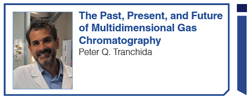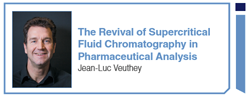The Past, Present, and Future of Multidimensional Gas Chromatography
LCGC Europe
The concept of (heart-cutting) multidimensional gas chromatography (MDGC) was introduced shortly after the invention of gas chromatography (GC). In that first experiment, the term “two-stage” was used to define the multidimensional process in applications involving the heart‑cutting of four hydrocarbon fractions, ranging from C5 to C8. The latter were separated first on a nonpolar packed column, and then on a polar one. A rather complex combination of valves enabled two-dimensional (2D) analysis. The great potential of the approach became immediately evident.

Heart-Cutting Multidimensional GC
The concept of (heart-cutting) multidimensional gas chromatography (MDGC) was introduced shortly after the invention of gas chromatography (GC) (1,2). In that first experiment (1), the term “two-stage” was used to define the multidimensional process in applications involving the heartâcutting of four hydrocarbon fractions, ranging from C5 to C8. The latter were separated first on a nonpolar packed column, and then on a polar one. A rather complex combination of valves enabled two-dimensional (2D) analysis. The great potential of the approach became immediately evident.
Heart-cutting MDGC is essentially a pretargeted analytical approach because it focuses on specific analytes characterized by a non-sufficient separation on a conventional GC column: A high-resolution secondâdimension (2D) separation is performed on one or more subsamples, isolated at the outlet of the first dimension (1D). The resulting separation power can be measured by summing the 1D peak capacity (1nc) with that of the second column (2nc), multiplied by the number of heart cuts. Typical applications involve enantiomers in essential oils, allergens in perfumes, aromas detected by olfactometry (O), and the measurement of compound-specific isotopic ratios (3). Heart-cutting MDGC has a fundamental role, for example, when gas chromatography–olfactometry (GC–O) or gas chromatography–mass spectrometry (GC–MS) fail to provide reliable data: Obviously, the human nose cannot separate coeluting odours, while MS cannot distinguish between overlapping isomers, such as terpenes. In such examples, the high-resolving power of a 2D conventional GC column most often enables the clear isolation of target compounds from the matrix.
Nowadays, the most commonly used and efficient transfer devices are those based on the Deans switch principle (4). Such interfaces possess a series of unquestionable advantages over in-oven valve systems. Current-day heartâcutting MDGC instruments produce highly repeatable and accurate information, require a low degree of maintenance, and are equipped with software for method optimization, instrumental control, and data processing.
An environmental research example highlighting the utility of heart-cutting MDGC was reported by Devos et al. (5). The authors found that, when using GC combined with triple quadrupole MS, the quantification of tributyltin (TBT) in water was problematic at levels below 2 ng/L as result of the presence of an interference. The use of a heart-cutting MDGC approach enabled the complete separation of TBT from the interference, and hence the correct quantification at very low concentration levels (5).
Comprehensive Multidimensional GC
The concept of comprehensive two-dimensional chromatography was described before the invention of GC (6). Chromatography pioneers performed a planar 2D separation on paper. Specifically, a series of amino acids was developed in one direction, and then in a second direction orthogonal to the first, by rotating the paper plane by 90° (a different mobile phase was also used). In such a manner, the entire sample was subjected to two independent separation processes.
At the beginning of the 1990s, the first comprehensive 2D-GC (GC×GC) experiment was performed by Phillips and co-worker (7). Entrapment and re-injection processes (defined as modulation) were performed in a continuous and sequential manner on the effluent exiting the first column. Entrapment occurred within the transfer device (defined as modulator) on a thick film of stationary phase (phase-ratio focusing), while re-injection was induced through thermal desorption (the modulator was electrically-heated). Again, the potential of such an ultrahigh-resolution method became immediately apparent.
The power of comprehensive 2D-GC is most often demonstrated in untargeted applications: the ultrahigh peak capacity (1nc × 2nc) of GC×GC can enable the generation of chromatograms containing hundreds, and in some cases thousands, of peaks.
Nowadays, the most commonly used and efficient transfer devices are cryogenic modulators, followed at some distance by flow modulators (8). Considering flow modulation, again, the most efficient devices in my opinion are those based on the Deans switch principle. State-of-the-art GC×GC systems produce data with a high degree of precision and accuracy, can be operated in a stable manner over prolonged time periods, and are often accompanied by software for method development, control of the high number of GC×GC parameters, and data processing.
An essential oil investigation illustrating the superior separation power of cryogenically modulated GC×GC was described by Filippi et al. (9). Four types of vetiver oil were subjected to analysis, initially using GC–MS. A single quadrupole mass analyzer was used. A total ion current GC–MS chromatogram for a Haitian oil contained 101 peaks; the number of detected peaks increased by more than five times when using GC×GC–MS (9).
Final Observations
To date, heart-cutting MDGC has a history of nearly 60 years, while GC×GC has been used for just over a quarter of a century. Heart-cutting MDGC can be considered a rather mature technology, very useful even though not widely diffused, with future evolution most probably involving the introduction of more compact instrumentation. Heart-cutting MDGC has gained itself a stable and well-established position within the GC field.
There is more space for evolution in the GC×GC field, which will probably relate to the modulation process and software packages, as well as to the development of more compact systems. Comprehensive MDGC is certainly a spectacular approach for untargeted applications, with many unprecedented separations published over the last two decades (4). However, and differently from heart-cutting MDGC, the method still lacks a well-defined analytical role. Perhaps such an aspect will change over time.
Finally, it is noteworthy that the Deans switch concept is one common to specific forms of heart-cutting and comprehensive MDGC. A unified transfer device, capable of performing both types of MDGC, would be an attractive option. Recent research has been performed on such a transfer system (10).
References
- M.C. Simmons and L.R. Snyder, Anal. Chem. 30, 32–35 (1958).
- A.T. James and A.J.P. Martin, Biochem. J. 50, 679–690 (1952).
- P.Q. Tranchida, F.A. Franchina, and L. Mondello, Flavour Fragr. J. 32, 218–227 (2017).
- P.J. Marriott, S-T. Chin, B. Maikhunthod, H-G. Schmarr, and S. Bieri, TrAC – Trend. Anal. Chem. 34, 1–21 (2012).
- C. Devos, F. David, and P. Sandra, J. Chromatogr. A 1261, 151–157 (2012).
- R. Consden, A.H. Gordon, and A.J.P. Martin, Biochem. J. 38, 224–232 (1944).
- Z. Liu and J.B. Phillips, J. Chromatogr. Sci. 29, 227–231 (1991).
- M. Edwards, A. Mostafa, and T. Górecki, Anal. Bioanal. Chem. 401, 2335–2349 (2011).
- J-J. Filippi, E. Belhassen, N. Baldovini, H. Brevard, and U.J. Meierhenrich, J. Chromatogr. A 1288, 127–148 (2013).
- J.V. Seeley, N.E. Schimmel, and S.K. Seeley, J. Chromatogr. A (2017) DOI: 10.1016/j.chroma.2017.06.030.
Peter Q. Tranchida is an associate professor in food chemistry in the Department of Chemical, Biological, Pharmaceutical, and Environmental Sciences at the University of Messina, in Messina, Italy.

Analysis of Pesticides in Foods Using GC–MS/MS: An Interview with José Fernando Huertas-Pérez
December 16th 2024In this LCGC International interview with José Fernando Huertas-Pérez who is a specialist in chemical contaminants analytics and mitigation at the Nestlé Institute for Food Safety and Analytical Sciences at Nestlé Research in Switzerland, In this interview we discuss his recent research work published in Food Chemistry on the subject of a method for quantifying multi-residue pesticides in food matrices using gas chromatography–tandem mass spectrometry (GC–MS/MS) (1).
The Use of SPME and GC×GC in Food Analysis: An Interview with Giorgia Purcaro
December 16th 2024LCGC International sat down with Giorgia Purcaro of the University of Liege to discuss the impact that solid-phase microextraction (SPME) and comprehensive multidimensional gas chromatography (GC×GC) is having on food analysis.















